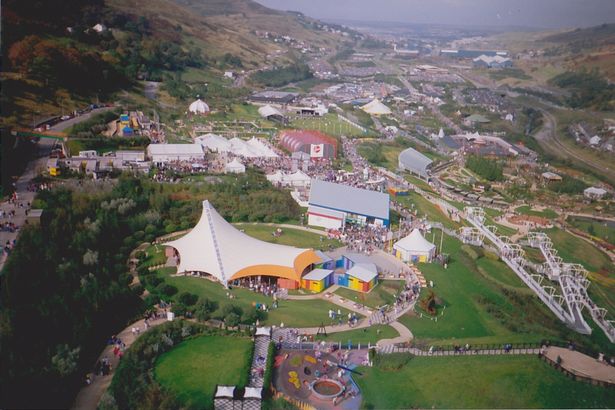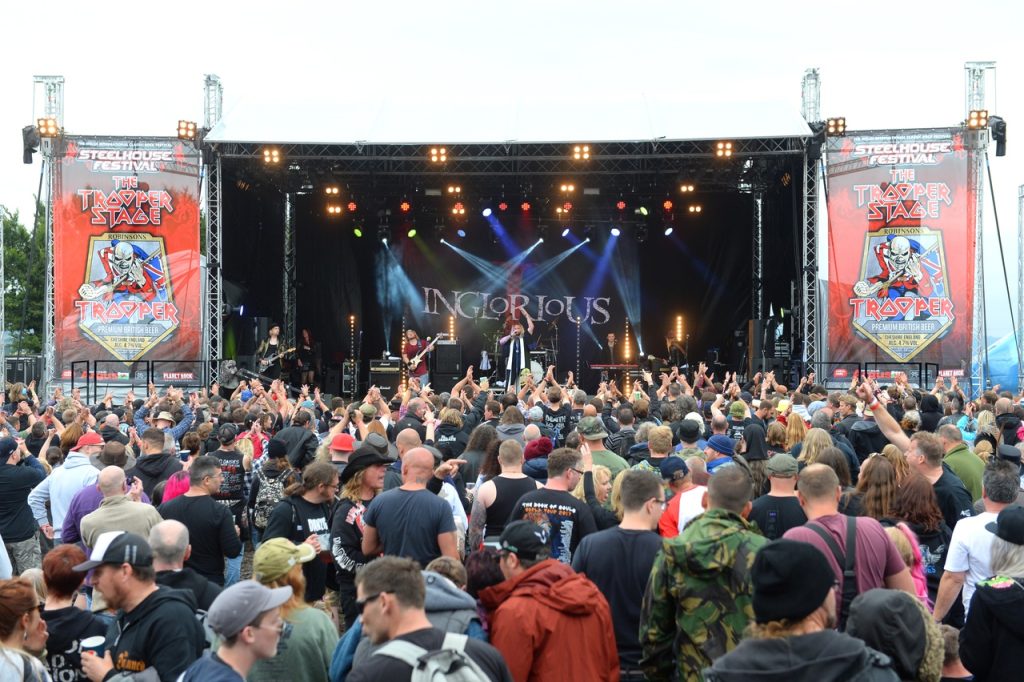Ebbw Vale

EBBW VALE is a town at the head of the valley formed by the Ebbw Fawr tributary of the Ebbw River, first developed as a coal-mining centre and later famous for its steel production. It is the largest town and the administrative centre of Blaenau Gwent county borough.
Iron was processed there beginning in the late 18th Century, using local coal, ore, and limestone. Steel production followed later, but the problems of the British steel industry in the 1970s led the works to close down its steelmaking operations and coal mining had ceased in the area by the end of the 20th Century.
The collapse of the town’s chief industries brought economic hardship. Ebbw Vale continues to produce tinplate and has other light industries and a shopping centre.
The Ebbw Vale and Brynmawr conurbation has a population of roughly 33,000. It has direct access to the dualled A465 Heads of the Valleys trunk road and borders the Brecon Beacons National Park.
Leading attractions to visit in Ebbw Vale are Festival Park Owl Sanctuary, Super Tubing, Ebbw Vale Works Museum and Ebbw Vale Sports Complex.
There is evidence of very early human activity in the area. Y Domen Fawr is a Bronze Age burial cairn above the town and at Cefn Manmoel there is a demarcation dyke believed to be of neolithic or medieval origins. In relatively modern times the area was a quiet uplands spot in rural Monmouthshire. With only about 120 inhabitants at the end of the 18th Century, Ebbw Vale and the whole area was transformed by the Industrial Revolution.
Ebbw Vale Iron Works, which later became the Ebbw Vale Steelworks, opened in 1778, followed by the opening of a number of coal mines around 1790. Rails for the Stockton and Darlington Railway were manufactured at Ebbw Vale in 1829. Steel from Ebbw Vale was used to construct the Sydney Harbour Bridge.
At its height (1930s-40s), the steelworks in Ebbw Vale was the largest in Europe, although it attracted very little attention from German bombers during World War II. By the 1960s, around 14,500 people were employed at the steelworks.
The end of the century witnessed a massive collapse of the UK steel industry. A strike in 1980 was followed by closures and redundancies which resulted in the dismantling of many of the old plants. In 2002 only 450 were employed in the old industries, and by July of that year the final works closed. Today there are no steelworks or mines left in the area. However, Ebbw Vale is still recognised for its innovation and contribution to the development of Britain as an industrial nation.
In 2003, work began on demolishing and redeveloping the steelworks site. By 2015 the site had been completely revamped with a new hospital, college campus, school and leisure centre.
In 1992, the Ebbw Vale Garden Festival was sited on the south side of the recently demolished steelworks. The festival ran for five months between May and October 1992, attracting over two million visitors. The development cost around £18 million. The site was later considerably redeveloped with new housing, some light industry and the Festival Park Branded Outlet, a retail outlet comprising approximately 40 shops.

The Ebbw Vale Steelworks site known as ‘The Works’ was re-developed under a £350m regeneration project by Blaenau Gwent Council and Welsh Government using EU redevelopment funding.
The Environmental Resource Centre (ERC) is an educational facility run by Gwent Wildlife Trust. Designed by Cardiff University’s Design Research Unit and located on the Hotmill Plateau, it was the first building to be completed as part of the redevelopment of the former steelworks site in Ebbw Vale. The centre is located on an ecologically rich site next to the Pumphouse cooling ponds, which have become a haven for wildlife since the closure of the steelworks. It was officially opened in 2010.
The General Offices is a Grade II listed building undergoing renovation. Built between 1913 and 1915, it formed part of the steelworks site. A brand-new modern extension (contrasting with the original building) officially opened on October 24, 2010, and houses the Gwent Archives.
The Queen officially opened the General Offices as part of her Diamond Jubilee Tour on May 3, 2012, accompanied by the Duke of Edinburgh.
As part of the Cultural Olympiad for the London 2012 Olympics, Adain Avion, a mobile art space created from the fuselage of a DC-9 aircraft, visited the General Offices.
Ebbw Vale first hosted the National Eisteddfod in 1958. The Welsh language was dominant in the area until the last quarter of the 19th Century when industry brought workers in from outside the area, and remnants of the language (Welsh hymns and pockets of Welsh being spoken in nearby Rhymney) persisted into the 1970s. The National Eisteddfod returned to Ebbw Vale in 2010.
Aneurin Bevan, the Labour Party politician who was main architect of the National Health Service (NHS), was the Member of Parliament (MP) for Ebbw Vale from the 1929 general election until his death in 1960, when he was succeeded as MP by Michael Foot. The seat joined with the neighbouring Abertillery constituency to form Blaenau Gwent.
In 2010, the former community of Ebbw Vale was abolished and replaced by Ebbw Vale North and Ebbw Vale South. The Ebbw Vale conurbation today runs in an almost unbroken housing street plan three miles or so from Beaufort in the north to Cwm in the south. There are significant areas of modern housing to the north and south of the town.
Ebbw Vale is host to a selection of primary schools and infant schools, two secondary schools – Ebbw Fawr Learning Community and Brynmawr Foundation School – both covering a large catchment area. Alongside this there is also the Ebbw Vale campus of Coleg Gwent, a Further Education college teaching a range of subjects from mechanics, media studies, humanities to hairdressing and beauty therapy. There is also an institute which provides a range of courses for mainly adult learners.
Wales’s first all individual bed hospital, Ysbyty Aneurin Bevan, opened in 2010.
Ebbw Vale sporting organisations have a long history. Rugby and cricket have flourished, with the town’s Eugene Cross Park as their home.
Ebbw Vale Rugby Football Club can trace its roots back to the 1890s. Nicknamed the ‘Steelmen’ after the area’s former industrial base, they have a successful record with many players achieving international honours, including British Lions and Scotland captain Arthur Smith. By 2015, they were playing at a semi-professional level in the Welsh Premiership just one level below regional rugby.
Cricket predates rugby in the area with the first recorded match as far back as 1852. The town’s association with the game grew such that until the early 2000s Glamorgan County Cricket fixtures were regularly held at Eugene Park.
Bowls, swimming and other football and rugby teams play locally at varying levels. The town’s leisure centre has facilities including a 33-metre swimming pool. Beaufort Theatre, the largest in Blaenau Gwent, holds regular music, drama and other cultural events.
In 2009, the town centre underwent a great deal of improvements, including the addition of a major artwork in the form of a 10.5-metre-high clock that cantilevered over the central boulevards.
A railway service to Cardiff Central began on February 6, 2008, with trains serving the town from the new Ebbw Vale Parkway railway station. An extension of the line to a new northern terminus, Ebbw Vale Town, was opened on May 17, 2015.
A kilometre-long funicular was part of the Garden Festival in 1992, but closed afterwards. In June 2015 a new inclined elevator, the Ebbw Vale Cableway, was opened. The lift was built by ABS Transportbahnen (Doppelmayr Garaventa Group). Its length is 57 metres (187ft) and has a vertical lift of 24 metres (79ft). The short, 20-second journey is free to travel and is intended to improve access between levels in the town, from ‘The Works’ site and Coleg Gwent, up to the town centre.
Reception of the funicular was mixed. Most criticism focused on the £2.3m cost, at a time when Blaenau Gwent Council were facing a £10m deficit and other services in the area hit by substantial cuts. The project was funded through the Welsh European Funding Office (WEFO) with most of the money being European-sourced and the local council providing around a third.
One of the main features of the festival was a mechanical clock created by sculptor Andy Plant, which became known as In the Nick of Time’. Costing £100,000, the clock was commissioned and paid for by Newport Council and would eventually move to John Frost Square, Newport. When the clock chimed each hour, the structure would open to reveal a series of hidden characters inside.
After being moved from the John Frost Square in 2008, the timepiece was bought by developers and now sits on a roundabout on the Queensway, near a housing development in Llanwern.
The Steelhouse Festival is held in the spectacular surroundings of Hafod-y-Dafal Farm, Aberbeeg, situated on the southern edge of the Brecon Beacons.

Billed as one of the UK’s best-value rock festivals, the event has built up a loyal following and a real heritage over many successful years. Classic rock cornerstones such as Thin Lizzy, Thunder, The Darkness, UFO, Europe, Uriah Heep, Glenn Hughes, Saxon and Skindred are among those who have etched their names into Steelhouse history.
Well-known people from the Ebbw Vale area include fashion designer Jeff Banks, Clive Burgess, nicknamed ‘steel claw’, a rugby player for both Wales and Ebbw Vale RFC, long-serving MP Michael Foot, singer and actor Brian Hibbard, marathon world record-breaker Steve Jones, Cwm-born actor Victor Spinetti and three-time world snooker champion Mark Williams.
Among other notables are Nicky Grist (rally co-driver), Jackson Page (world under-18 snooker champion), Jemima Phillips (harpist), Nathan Wyburn (pop culture portrait artist), Sir Frederick Brundrett (civil servant and mathematician) and Dai Davies (politician).
(sources include Britannica, Wikipedia, Trip Advisor, Wales Online)
Back to HOME PAGE